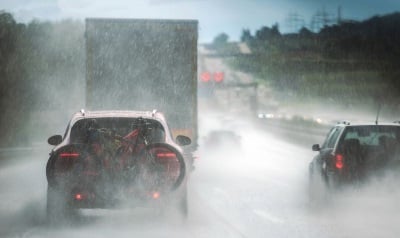Researchers say they have developed a device that prevents vehicles including HGVs from aquaplaning during adverse road conditions.
 The Run Dry Traction System (RDTS) prevents water and other contaminants from reaching a vehicle’s tyres by firing a jet of compressed gas close to the front of the wheel.
The Run Dry Traction System (RDTS) prevents water and other contaminants from reaching a vehicle’s tyres by firing a jet of compressed gas close to the front of the wheel.
The effect is to remove water in front of the tyre and establish that the vehicle has a dry patch of road ahead.
The scientists at Coventry University said this process effectively ensures grip is not compromised.
Mike Blundell, professor of vehicle mechanics and impact, said: “Our tests demonstrate that RDTS has the potential to make a huge impact on vehicle safety in a whole host of conditions.
“The prospect of producing something that could even save lives on the road is extremely exciting and after some initial success with testing, we’re now eager to look into manufacturing potential and further research to take this concept to the next level.
“A device like this really could be the difference between life and death if it can help vehicles to stop safely within certain distances and that’s why we’re so keen to continue developing this concept,” he added.
The university said RDTS had been designed to be fitted to a range of vehicles, including trucks, buses, cars and motorcycles and with further development could even be used to improve aircraft ground operations and rail transport safety.




















Ron
( Monday, October 4, 2021 - 14:21 )
All the effort that goes in to spray suppression, and now they want to blast the water off the road, I can just imagine the spray that’s going to go everywhere, thus reducing visibility, and thus safety.
It’s not clear if this is constant air jet, or just when breaking, but it will require large amounts of compressed air, which means suitable storage tanks, and a suitably sized compressor. Driving a compressor means more fuel used, also due to the increased weight to haul around.
I really can’t see this being practical, you’d need a sidecar on a motorbike for the air tanks and compressor 😉